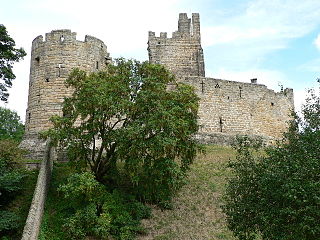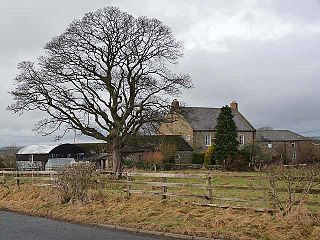Baron Ogle is an abeyant title in the Peerage of England. It was created in 1461 for Robert Ogle. It fell into abeyance in 1691. The Ogles were a prominent Northumbrian family from before the time of the Norman Conquest. They settled at Ogle, Northumberland and in 1341 were granted a licence to fortify their manor house which became known as Ogle Castle. The family included seven Medieval Barons. Their estates fell by marriage to the Cavendish family following the death of the 7th Baron in 1597.
Berwick Hill is a village and former civil parish, now in the parish of Ponteland, in the county of Northumberland, England. It is situated to the north of Newcastle upon Tyne, near Ponteland. In 1951 the parish had a population of 41.

Bolton is a small village and former civil parish, now in the parish of Hedgeley, in the county of Northumberland, England. It is situated on the north side of the River Aln, about two miles (3 km) east by north from Whittingham, and 5+1⁄2 miles west from Alnwick. It has a chapel and a small number of residential properties.

Cambo is a village and former civil parish, now in the parish of Wallington Demesne, in Northumberland, England. It is about 11 miles (18 km) to the west of the county town of Morpeth at the junction of the B6342 and B6343 roads. The village was gifted along with the Wallington Estate to the National Trust by Sir Charles Philips Trevelyan in 1942, the first donation of its kind. It remains a National Trust village. In 1951 the parish had a population of 60.

Newminster Abbey was a Cistercian abbey in Northumberland in the north of England. The site is protected by Grade II listed building and Scheduled Ancient Monument status.
This is a list of the High Sheriffs of the English county of Northumberland. The High Sheriff is the oldest secular office under the Crown. Formerly the High Sheriff was the principal law enforcement officer in the county but over the centuries most of the responsibilities associated with the post have been transferred elsewhere or are now defunct, so that its functions are now largely ceremonial. The High Sheriff changes every March.

Eshott is a village and former civil parish, now in the parish of Thirston, in Northumberland, England. In 1951 the parish had a population of 114.
Stanton is a small hamlet and former civil parish, now in the parish of Netherwitton, in Northumberland, England, which is located 7 miles (11 km) north west of Morpeth, and 15 miles (24 km) north of Newcastle upon Tyne. Stanton is 9 miles (14 km) from the Northumberland National Park (NNPA). In 1951 the parish had a population of 70.

Aydon Castle, previously sometimes called Aydon Hall, is a fortified manor house at Aydon near to the town of Corbridge, Northumberland, England. It is a Scheduled Ancient Monument, and is designated by English Heritage as a Grade I listed building.

Kirkley Hall is a 17th-century historic country mansion and Grade II listed building in Northumberland, England. The estate is over 190 acres (0.77 km2) and adjoins the River Blyth at Kirkley, three miles north of Ponteland in the heart of the Northumberland countryside, which is now a Horticultural and Agricultural training centre.

Morpeth Castle is a Scheduled Ancient Monument and a Grade I listed building at Morpeth, Northumberland, in northeast England. It has been restored by the Landmark Trust and is now available as a holiday rental home.

The Ogle baronetcy, of Worthy, was a title in the Baronetage of the United Kingdom. It was created on 12 March 1816 for Admiral Chaloner Ogle, of Kings Worthy, Hampshire. The Ogles were a prominent Northumberland family from before the time of the Norman Conquest. They settled at Ogle, Northumberland, and in 1341 were granted licence to fortify their manor house, which became known as Ogle Castle. In the 14th and 15th centuries the family included seven medieval Barons. Their estates, including Ogle and Bothal Castle, fell by marriage to the Cavendish family on the death of the 7th and last Baron, without male heir in 1597.

Sir Chaloner Ogle, 1st Baronet was an officer of the Royal Navy. He served during the Seven Years' War, American War of Independence, and the French Revolutionary and Napoleonic Wars.
The Ogle family were prominent landed gentry in Northumberland. The earliest appearances of the family name were written Hoggel, Oggehill, Ogille and Oghill.

Prudhoe Castle is a ruined medieval English castle situated on the south bank of the River Tyne at Prudhoe, Northumberland, England. It is a Scheduled Ancient Monument and a Grade I listed building.

Ouston is a village and former civil parish, now in the parish of Stamfordham, in the county of Northumberland, England. In 1951 the parish had a population of 13.

Kirkharle is a village and former civil parish, now in the parish of Kirkwhelpington, in the county of Northumberland in Northern England located about 12 miles (19 km) west of the town of Morpeth, just to the west of the crossroads of the A696 and B6342 roads. It is famous as the birthplace of Lancelot 'Capability' Brown in the early eighteenth century, Britain's most celebrated landscape gardener. In 1951 the parish had a population of 69.

Hadston is a village and former civil parish, now in the parish of East Chevington, in Northumberland, England, about 2.5 miles (4 km) south of Amble. In 1951 the parish had a population of 196.

Scrainwood is a hamlet and former civil parish 20 miles (32 km) from Morpeth, now in the parish of Alnham, in the county of Northumberland, England. In 1951 the parish had a population of 16. Scrainwood Estate is 1048 acres and has a shoot that specializes in partridges.

Eachwick is a hamlet and former civil parish 11 miles (18 km) from Morpeth, now in the parish of Stamfordham, in the county of Northumberland, England. In 1951 the parish had a population of 69.
















